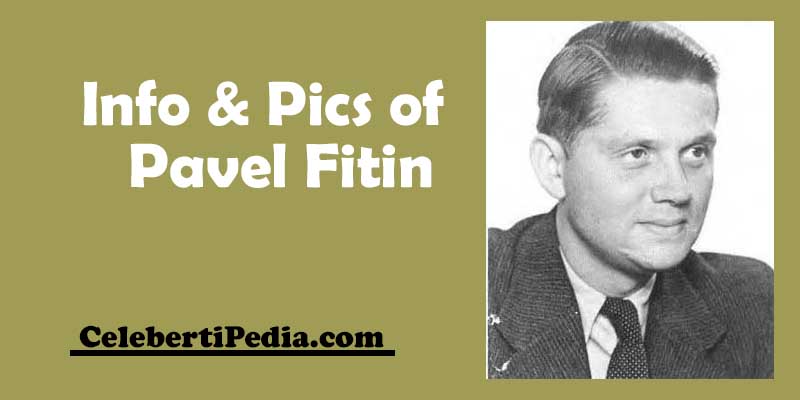
Here you get the best information related to Celebs. In this article, we are sharing Knowledge on Info and Pics of Pavel Fitin . We hope you like this article.
You can also read these articles:
- Garry Tonon’s Sister & Parents Info & Pics Collection
- Mark Bell With His Wife Rare Photos Collection
- info & 10 Pics of Julia Erokhina-Guide2022
- Top 10 Pics Of Elanna Pecherle With Her Husband
- Top 9 Pics Of Irene Khan (irenesarah) With Her Husband
Info and Pics of Pavel Fitin
Biography
Honorary State Security Officer Pavel Fitin headed the first main KGB department of the Soviet Union for several years. Leading foreign intelligence in times of war and peace, the major general (and later lieutenant general) went to great lengths to provide information on the plans of the foreigners to the politicians who ruled the kingdom and the entire land. But he has had amazing results. He was obtained in the construction of information networks.
Childhood and youth
Biography of Pavel Mikhailovich Fayton began in Tobolsk province, he was born in 1907 in the village of Uzhugino. The peasant family led by father Mikhail Fayton was engaged in agriculture, many representatives held elective honorary positions.
This situation allowed the young Pasha to study in the primary school of the region. After graduating from a seven-year school, the boy immediately entered Zvezda Artel as an assistant. In the 1920s, he went to Yaloturovsk to continue his education. Following the example of his older classmates, the student joined the members of the Komsomol organization and began to prepare for admission to an institute or university.
As the White Guard movement in Russia intensified, a 14-year-old teenager, along with his father and other residents of the village, was considered a group, imprisoned and sentenced to death. The red detachments released the prisoners and gave them a second life.
In nature, Fitin began to take revenge for the help of the country, which was celebrating the anniversary of the October Revolution. The boy was hired by the Komsomol district committee. A born activist and leader, he headed the Office of Young Leninists-Pioneers and later served as secretary of the regional youth organization.
In the late 1920s, the social worker moved to central Russia. After a stay in Moscow, he entered the design and research department of the Academy of Agriculture. K.A. Timiryazev established himself as a talented student. After an internship at a large company, she got a job as an engineer at the National Institute for Agricultural Mechanization (later renamed Faculty of Agricultural Technology).
From 1932 to 1934, Pavel held the position of editor-in-chief of technical literature. His career was interrupted after he was drafted into the Soviet army. After his demobilization, the working “peasant”, a former soldier in the Red Army, returned to the Moscow printing press and took one of the most important positions. job
Pitin’s political activities began in the late 1930s, during which mass repression caused a shortage of qualified manpower in countries that needed staff, a central administrative body, the People’s Committee for the Interior, to ensure national security. .
With hundreds of young Komsomol members from all over the country, Pavel went through every step of careful selection and was placed in an educational institution under the supervision of an NKVD representative. After taking a brief introductory lecture on trade and completing an internship at GUGB, a foreign intelligence agency, the former agricultural worker became a detective and then head of one of the experts. section
The highest praise for the leadership of the People’s Commissar of the Interior of the USSR Lavrenty Pavlovich Beria was appointed head of the main department of the State Security Agency. Fortunately, the ambitious young employee did not turn to the State Commissioner. It saved lives during Khrushchev’s suppression.
At the helm of the Soviet Union’s foreign intelligence agency, Fitin applied the skills he acquired early in his career. The first tangible results came just before the Second World War.
Pavel Mikhailovich’s men sent hundreds of reports and dispatches to Joseph Stalin before the Nazis began. The Soviet leadership was aware of the plans of the German command and, according to some rumors, was aware of the exact date of the attack, but could not assess the magnitude of the threat and predict the enemy’s actions. Fitin then initiated the creation of an information and analysis department.
When the Germans invaded the territory of the Soviet Union in the summer of 1941, Pavel Mikhailovich was at the center of political events. He was responsible for establishing contact with agents on the enemy side. The head of the foreign intelligence service of the USSR personally trained the employees who worked in the occupied countries. Thanks to this, the Tehran Conference was held and a turning point took place during the Great Patriotic War.
In parallel, Pavel Mikhailovich received information about the project to create nuclear weapons. The experience of British scientists became the property of the NKVD. After carefully examining the data, the best minds in the Soviet Union took part in a colossal operation to create an atomic bomb.
Overseas agents discovered documents in America that made development faster and cheaper. As a result, the Franklin Roosevelt government failed to become a monopoly in the field of advanced military technologies that ensured “sustainable peace.”
After the war
After the war, Fitin was relieved of his senior position in the foreign intelligence department and, on the orders of Lavrenty Beria, was sent as an employee of the Ministry of State Security to keep order in the Soviet occupation zone of Germany. The authors of biographies believed that in this way the country’s leadership ensured control over the nuclear program deployed in a number of forbidden secret zones.
It was believed that the intelligence officer supervised the specialists working on the creation of nuclear weapons, hunted for the most valuable chemical element uranium and kept order at the test site in Semipalatinsk, as well as nearby “closed cities”.
The death of Joseph Stalin and the arrest of Lavrenty Beria had a negative impact on the fate of Pavel Mikhailovich. Nikita Khrushchev , who came to power, did not appreciate past merits. Vitin, who at that time worked at the Sverdlovsk Department of Internal Affairs, was fired without explanation. As a result, the man who repeatedly saved his homeland from foreign enemies had to stop his work in the State Control Committee of the USSR.
Private life
During the Soviet era, Witten’s personal life was kept secret. Then the information appeared that the scout was legally married three times.
With his first wife, Alexandra Martynov, Pavel Mikhailovich raised his son Anatoly, who supported the family traditions and rose to the rank of lieutenant colonel in the FSB. Over time, the first child gave his father grandchildren Andrei and Elena, who received a proper education and became professionals in various fields.
This scout did not live long with his second wife Lilia Blucher. The separation occurred for unknown reasons after the birth of two children.
Outsiders know nothing of the third chosen one. According to photocopies of archival documents, this woman was close to Fitin until the last days. dead
In December 1971, deaths from unknown causes overtook the head of the Soviet foreign intelligence service. On the day of the funeral, relatives and friends gathered at the grave in the Vvedensky cemetery.
The exceptional civic memory immortalized the names of the commemorative plaques, monuments and streets of the towns he visited. Fitin’s footage has been used in documentaries and feature films. A native of the Tobolsk region, he became the prototype for Alex, the leader of the Stalitz, in the cinematic epic 17 Minutes of Spring.
Memory
- 1973 – In the series “Seventeen Moments of Spring” he became the prototype of Vladimir Nikolaevich Gromov (“Alex”). Actor Pyotr Chernov
- 2008 – Memorial plaque in the village of Ozhogino, Kurgan region
- 2014 – A memorial plaque in Yalutorovsk on the building of the former school where Pavel Fitin studied
- 2016 – Memorial plaque in Yekaterinburg on the building of the Sverdlovsk FSB
- 2017 – Monument to Pavel Fitin in Moscow, near the building of the press office of the Russian Foreign Intelligence Service
- 2020 – Pavel Fitin Street in the Moscow district of Yasenevo (previously Projected passage No. 5063)
- 2020 – The summit of Pavel Fitin in the Republic of North Ossetia-Alania (height 4076 meters)
Awards
- 1939 – Military Cross Czechoslovakia
- 1940 – Two Orders of the Red Banner (USSR)
- 1942 – Badge “Honored Worker of the NKVD” No. 000623 (USSR)
- 1943 – Order of the Red Star (USSR)
- 1943 – Order of the Republic (Tyva)
- Grand Officer of the Order of the White Lion (Czechoslovakia)
- Order of the Partisan Star, 1st class (Yugoslavia)
- 8 medals
Interesting Facts
- Experts have rebuilt Germany’s leading network and sent residents to dozens of developing countries. As part of a review of the staff’s work, Pavel Mikhailovich went secretly in Berlin. A few months later, a colleague who remained in Russia reported that in the absence of a scout, German police director Walter Schellenberg was conducting an anonymous
- reconnaissance on the ground in Moscow.
- When it became clear that the collapse of the Nazi regime was inevitable, Fitin focused on allies outside the Soviet Union who were discussing the postwar world order. On the eve of the Yalta Conference, Stalin was informed that Winston Churchill and Franklin Delano Roosevelt were playing a fraudulent game. Over the years of service, the intelligence officer, who became a Soviet lieutenant general, repeatedly received orders and decorations. In his memoirs, he mentioned that he was most concerned during the ceremony of honoring the honorary certificate and badge “Honored Worker of the NKVD”.

